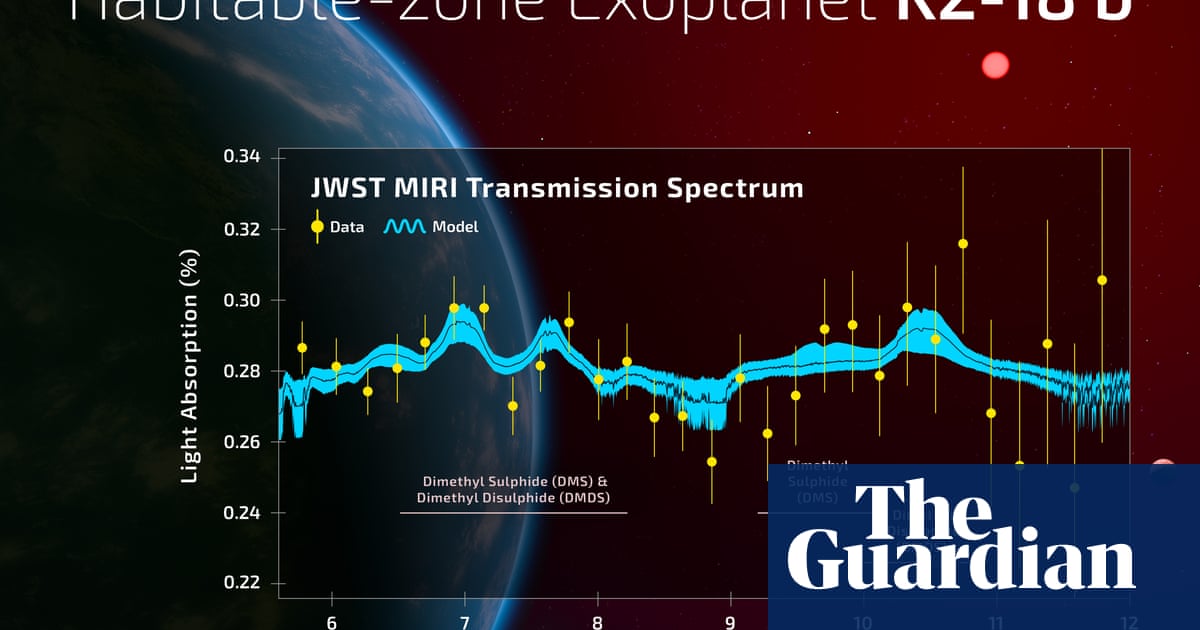Photo credit: www.theguardian.com
Towards the final chapters of his life, renowned physicist Stephen Hawking reflected on humanity’s search for extraterrestrial intelligence. In 2016, he assessed the likelihood of making such a discovery within the next two decades as quite slim, stating, “The probability is low,” before hesitantly adding, “Probably.”
Recently, a research team from the University of Cambridge unveiled preliminary findings that suggest the presence of two specific compounds in the atmosphere of K2-18b, a planet located in the Leo constellation, approximately 124 light years away from Earth.
On our planet, dimethyl sulphide (DMS) and dimethyl disulphide (DMDS) are significant markers associated with biological activity, being produced solely by microscopic life forms. While these marine phytoplankton may not display signs of high intelligence, their implication in the atmosphere of K2-18b has sparked considerable enthusiasm. The age-old inquiry of whether we are alone in the universe suddenly feels a step closer to resolution.
Prof. Nikku Madhusudhan, an astrophysicist involved in the study, characterized this development as the strongest indication to date of biological activity beyond our solar system. He expressed hope that future generations may view this moment as pivotal in the quest for extraterrestrial life.
As observations with the James Webb Space Telescope (JWST) continue for the next two years, scientists anticipate a clearer understanding of the potential existence of these compounds in K2-18b’s atmosphere. Positioned roughly a million miles from Earth, the JWST is uniquely capable of making such critical measurements.
By observing planets as they transit in front of their stars, the JWST can identify subtle variations in starlight caused by atmospheric compounds. Through extensive data collection, astronomers can confirm the abundance of specific substances in the atmospheres of these distant worlds.
However, even if the compounds are detected, the existence of life remains an open question. Scientists must consider alternative methods through which these chemicals could be formed without the involvement of biological organisms.
While interpretations may be cautious, the overarching narrative is optimistic. Recent technological advancements have notably increased the potential for discovering extraterrestrial life. As stated by Monica Grady, emeritus professor of planetary science at the Open University, the evolution of equipment and methodologies plays a critical role in this newfound optimism.
The intriguing case of Venus serves as a prime example. In a groundbreaking study from 2020, a team led by Jane Greaves discovered phosphine in the planet’s clouds, a finding that seemed to imply a biological origin. This sparked significant debate, but subsequent confirmation from researchers at Imperial College London last year further validated the presence of phosphine, achieved through innovative techniques applied to existing technology.
Moreover, NASA’s Curiosity rover, which has been exploring Gale Crater on Mars for over a decade, recently employed new analytical methods that revealed long-chain alkanes in Martian rocks—organic materials typically associated with the degradation of biological cells.
Exciting developments are also evident in the realm of computational techniques. Scientists have yet to leverage artificial intelligence fully to analyze vast databases of past observations, which may hold secrets about the existence of life. New projects like the Square Kilometre Array in South Africa and Australia, as well as the Extremely Large Telescope in Chile, have yet to become operational, indicating that the next decade may yield even more discoveries.
While it is plausible that microbial life might be prevalent across the cosmos, the search for advanced life forms remains a significant challenge. The Breakthrough Listen initiative, launched in 2016, represents the most extensive endeavor to detect signals—known as “technosignatures”—from other civilizations. To date, the program has primarily encountered interference from Earthly sources, fueling ongoing intrigue but yielding no conclusive evidence of intelligent extraterrestrial life.
Anticipation builds as future missions gear up to probe for signs of life. NASA’s Europa Clipper, expected to arrive at Jupiter’s moon in 2030, is set to investigate the potential habitability of its subsurface ocean. Additionally, the forthcoming Habitable Worlds Observatory will be the first telescope specifically designed to seek out life signs from exoplanets.
The timeline for definitive answers regarding extraterrestrial life remains uncertain. Caroline Freissinet, an analytical chemist involved in the discovery of Martian organics, notes the complexities of establishing a threshold for determining life. The question persists: “At what probability can we assert that it’s life?” Whether we find ourselves 60% or 90% certain may not provide a satisfying conclusion, and complete certainty may forever elude us—unless an unmistakable encounter occurs, perhaps illustrated by a friendly creature appearing on camera.
Source
www.theguardian.com

